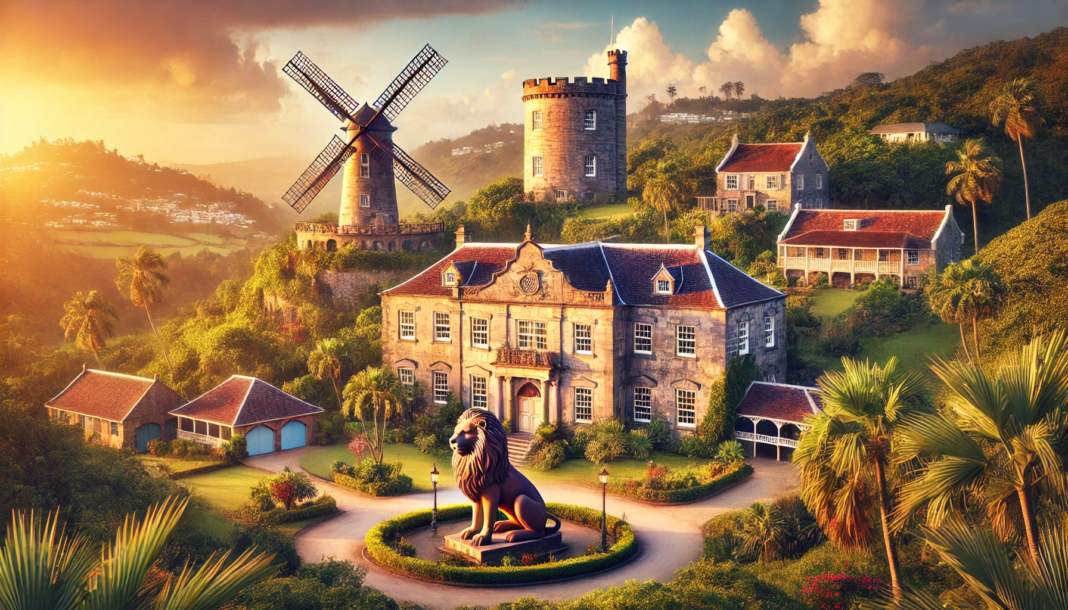Barbados is not only known for its white sandy beaches and crystal-clear waters but also for its rich history and well-preserved cultural heritage.
The island’s past, shaped by colonialism, African heritage, and the sugar trade, is deeply embedded in its architecture, monuments, and cultural landmarks. For visitors interested in diving into the historical depth of the island, Barbados offers a variety of sites that tell the story of its people, their struggles, and their triumphs.
Here is a guide to the top historical landmarks you should see when visiting Barbados, where history, culture, and beauty come together to offer a unique perspective of the island’s past.
1. St. Nicholas Abbey
St. Nicholas Abbey is one of the oldest surviving plantation houses in Barbados and a gem of the island’s historical architecture. Built in 1658, it is a stunning example of Jacobean architecture, one of only three such structures left in the Western Hemisphere. The house is set on a 400-acre plantation, and visitors can explore its beautiful grounds, historic distillery, and museum.
The plantation tells the story of Barbados’ sugar industry and its pivotal role in the island’s economy and colonial history. Visitors can also enjoy a tour of the rum distillery, where the production of rum has continued for centuries. St. Nicholas Abbey gives insight into the plantation lifestyle of the past while offering a glimpse into the island’s evolving rum-making tradition.
Highlights:
- Jacobean architecture
- Rum distillery tour and tasting
- Stunning gardens and sugar mill ruins
Location: St. Peter, Barbados
2. George Washington House
George Washington House is a key landmark in Barbados’ colonial history and the only known residence of the first U.S. president outside of the United States. George Washington stayed here during a visit to Barbados in 1751, when he accompanied his sick brother Lawrence in hopes of improving his health. This experience was instrumental in shaping Washington’s later decisions in life.
Today, the house is a museum that offers insight into colonial life in Barbados during the 18th century. Visitors can explore the rooms where Washington stayed and learn about the historical connections between Barbados and the United States.
Highlights:
- Colonial artifacts and furnishings
- Insight into George Washington’s Barbados stay
- Underground tunnels used in the defense of Bridgetown
Location: The Garrison, Bridgetown, Barbados
3. The Garrison Savannah and the Barbados Museum
The Garrison Savannah was once the British Empire’s largest military outpost in the Caribbean and now stands as a testament to Barbados’ colonial military history. Established in 1780, the Garrison was home to British soldiers stationed on the island and now encompasses a collection of historical buildings, including the Main Guard House, the National Armory, and the Barbados Museum and Historical Society.
The Barbados Museum, housed in the former British Military Prison, contains an extensive collection of artifacts that chronicle the island’s history from its indigenous inhabitants to the colonial period and beyond. Exhibits cover a range of topics, including African heritage, the island’s maritime history, and natural history.
Highlights:
- Historical military buildings
- The Barbados Museum’s extensive collection of artifacts
- A walking tour of the Garrison area
Location: Bridgetown, Barbados (UNESCO World Heritage Site)
4. Morgan Lewis Windmill
As one of the only two intact sugar windmills in the Caribbean, Morgan Lewis Windmill is a significant monument to Barbados’ sugar plantation history. Built in the early 18th century, it was used to grind sugar cane, which was one of the most important crops on the island. Today, it stands as a testament to Barbados’ role in the sugar industry and its colonial past.
The windmill is located in the parish of St. Andrew, offering picturesque views of the surrounding countryside. Visitors can explore the windmill and learn about the traditional methods of sugar production that once powered the island’s economy. The Barbados National Trust also runs the site, providing demonstrations of how the windmill worked during its operational days.
Highlights:
- Historical sugar mill machinery
- Beautiful views of the surrounding countryside
- An example of early Barbadian industrial architecture
Location: St. Andrew, Barbados
5. Bridgetown and its Garrison (UNESCO World Heritage Site)
The Historic Bridgetown and its Garrison area was designated a UNESCO World Heritage Site in 2011, due to its well-preserved British colonial architecture and its significance in the transatlantic trade system during the 17th, 18th, and 19th centuries. The capital city, Bridgetown, is a blend of colonial and modern buildings, offering visitors a chance to explore the historic heart of the island.
Stroll along Broad Street, the main commercial thoroughfare, or visit historical sites such as the Parliament Buildings, which house the third-oldest parliament in the Commonwealth, or National Heroes Square, once called Trafalgar Square, where a statue of Lord Nelson still stands.
The Garrison area, part of the UNESCO designation, was once a British military base and features historic military buildings, barracks, and parade grounds. Together, Bridgetown and the Garrison Savannah offer a deep dive into Barbados’ colonial past and its emergence as an independent nation.
Highlights:
- UNESCO World Heritage Site
- Parliament Buildings and National Heroes Square
- Colonial architecture and historic military buildings
Location: Bridgetown, Barbados
6. The Nidhe Israel Synagogue
Nidhe Israel Synagogue is one of the oldest synagogues in the Western Hemisphere, built in 1654 by Jewish settlers who fled persecution in Brazil. Located in Bridgetown, this synagogue is a testament to the rich multicultural history of Barbados and the presence of the Jewish community on the island.
The synagogue complex includes a beautifully restored synagogue, a museum, and a historic cemetery. Visitors can learn about the contribution of the Jewish community to Barbados’ sugar industry and their role in the island’s history.
Highlights:
- One of the oldest synagogues in the Western Hemisphere
- Interactive museum detailing the Jewish history in Barbados
- Historic Jewish cemetery with centuries-old tombstones
Location: Synagogue Lane, Bridgetown, Barbados
7. Gun Hill Signal Station
Gun Hill Signal Station, built in 1818, was one of six signal stations established on the island by the British military to facilitate communication across Barbados. Located in St. George parish, Gun Hill offers some of the most breathtaking panoramic views of the island. The signal station played a crucial role in Barbados’ defense system during the 19th century.
Today, visitors can explore the restored signal station, which houses a collection of military memorabilia. The station is also famous for its large stone lion sculpture, which was carved by a British soldier in 1868 and still stands proudly on the hillside.
Highlights:
- Panoramic views of Barbados from the top of the signal station
- Historical military artifacts and exhibits
- The famous carved lion statue
Location: St. George, Barbados
8. Arlington House Museum
Located in the historic town of Speightstown, Arlington House Museum offers a unique interactive experience for those interested in Barbados’ social and economic history. Housed in a beautifully restored 18th-century building, Arlington House presents exhibits on the island’s colonial past, the sugar trade, and the transatlantic slave trade.
Visitors can explore interactive exhibits that tell the story of Speightstown, a major port town during the colonial period, and its transformation over time. The museum also provides insights into daily life in Barbados during the 18th and 19th centuries, with a focus on trade and commerce.
Highlights:
- Interactive exhibits on Barbadian history
- Restored 18th-century colonial architecture
- Insight into the island’s maritime and trading history
Location: Speightstown, St. Peter, Barbados
9. Sam Lord’s Castle (Ruins)
Though in ruins, Sam Lord’s Castle is one of the most iconic landmarks in Barbados. Built in the 1820s by the notorious buccaneer Samuel Hall Lord, the mansion was reputedly used to lure ships onto the reefs using lanterns, causing them to run aground so they could be looted. Despite its storied past, the Georgian-style mansion was a stunning architectural achievement.
Although the castle was severely damaged by fire in 2010, efforts have been made to restore the property. Visitors can still tour the grounds and learn about the legendary history of Sam Lord, who became one of Barbados’ most infamous characters.
Highlights:
- The mysterious history of Sam Lord, the buccaneer
- Ruins of a once-grand Georgian mansion
- Plans for restoration and preservation of the site
Location: St. Philip, Barbados
Conclusion
Barbados offers a rich tapestry of historical landmarks that reflect its diverse cultural heritage and complex history. From the grandeur of St. Nicholas Abbey to the military relics of the Garrison Savannah, each site tells a unique story of the island’s past. Whether you’re interested in colonial history, the legacy of the sugar industry, or the multicultural influences that shaped the island, Barbados provides a captivating journey through time for history enthusiasts and curious travelers alike.
FAQ
What is the oldest historical site in Barbados?
St. Nicholas Abbey, built in 1658, is one of the oldest and best-preserved plantation houses in Barbados and the Caribbean, making it one of the island’s most important historical landmarks.
Where can I learn about Barbados’ Jewish history?
The Nidhe Israel Synagogue and its museum in Bridgetown offer a deep dive into the Jewish history of Barbados, including their role in the sugar industry and the establishment of the synagogue in 1654.
What is the significance of the Garrison Savannah?
The Garrison Savannah was once the largest British military outpost in the Caribbean, playing a significant role in the island’s colonial defense system. Today, it is part of the UNESCO World Heritage Site and features military buildings, the Barbados Museum, and historical monuments.
Can I visit a working rum distillery in Barbados?
Yes, St. Nicholas Abbey operates a working rum distillery where visitors can tour the facilities, learn about the rum-making process, and sample some of Barbados’ finest rum.
What is the best place to visit for panoramic views of Barbados?
The Gun Hill Signal Station in St. George parish offers breathtaking panoramic views of the island and features a historic signal station with military memorabilia.
What happened to Sam Lord’s Castle?
Sam Lord’s Castle, once a grand Georgian mansion, was severely damaged by fire in 2010. The site remains an important historical landmark, and restoration efforts are underway to preserve its legacy.

